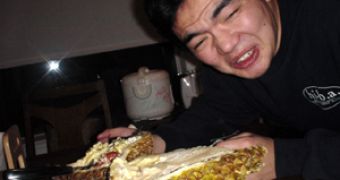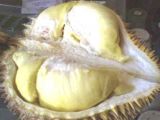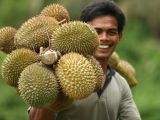Linden trees produce one of the most suave and persistent scent that a tree can produce but one of its relatives is the skunk of the fruits' world: the durian fruit, the product of the trees of the genus Durio.
In Southeast Asia is named the "King of Fruits," even if airlines, subways, hotels and public transportation in those countries do not allow clientele to enter them with durian in their possession.
Still, the very best durians are, per kilogram, the most expensive of all fruits during a normal harvest year.
It is consumed in Southeastern Asia by millenia, but Europeans first heard about it 600 years ago.
The fruit is unique due not only to its odor, but also for its large size (30 centimetres (12 in) long and 15 centimetres (6 in) in diameter (the size of a football ball), weighing 1-3 kg (2 to 7 lb)) and a formidable thorn-covered husk (in Malay durian means "thorny fruit").
Amongst the 30 Durio species, Durio zibethinus (a clear reference of the similarity between the stench and the scent emitted by the civet cats), original from Borneo, is the only species available internationally traded.
The fruit can be from oblong to round, the husk color green to brown and its flesh pale-yellow to red, depending on species.
The hard outer husk is covered with sharp, prickly thorns, while the edible custard-like flesh within emits the strong odor, which can be perceived either fragrant or overpowering and offensive.
For a westerner, the penetrating odor of durian can resemble cheeses like limburger.
"... its odor is best described as pig-shit, turpentine and onions, garnished with a gym sock. It can be smelled from yards away." said travel and food writer Richard Sterling.
Other compare the smell with civet, sewage, stale vomit, skunk spray, and used surgical swabs.
The smell can really vary also between the Durio species and the degree of ripeness.
In Malaysia and Singapore, durian is preferred quite ripe (thus stenchier) as the flesh turns richly creamy, slightly alcoholic, and the flavor highly complex.
Chemical analyses found in the stench esters, ketones and many thiols (organosulfur chemicals found also in feces, skunk scent, cheese or stale beer.
The strong smell is aimed to be detected by far away (0.5 mile or 800 m) away by animals, luring them to consume it, as they ingest this way the seeds and spread the plant.
Many animals indulge with durian, from squirrels to mouse deer, pigs, orangutan, elephants, and even tigers (!).
The taste of the flesh has been described as nutty and sweet.
The flesh is like a thick, rich, mildly sweet custard or soft brie-like cheese.
"A rich custard highly flavored with almonds gives the best general idea of it, but there are occasional wafts of flavor that call to mind cream-cheese, onion-sauce, sherry-wine, and other incongruous dishes. Then there is a rich glutinous smoothness in the pulp which nothing else possesses, but which adds to its delicacy." said the biologist Alfred Russel Wallace, one of the first Europeans tasting the fruit in the XIXth century.
Durian is rich in sugar, fats, vitamin C, potassium, and the serotoninergic amino acid tryptophan.
In Java, this stenchy fruit is even given aphrodisiac qualities.
Numerous cultivars of durian have arisen in southeastern Asia over the centuries, each with a distinct taste and odor. Some develop the odor about three days after the fruit is picked, allowing an odorless transport to the consumers who prefer the pungent odor.
Durian is in Thailand, Malaysia, Indonesia, Cambodia, Laos, Vietnam, Myanmar, India, Sri Lanka, Caribbean islands, Florida, Hawaii, Papua New Guinea, Polynesian Islands, Madagascar, southern China, northern Australia.
In United States and the European Community durian is sold frozen mainly by Asian markets.
Durian is used for many sweet edibles like candy, ice creams, dodol, rose biscuits, ice cream, milkshakes, mooncakes, cappuccino or mixed with coconut milk.
But this fruit can also be used in dishes fried with onions and chilli; soups made from fresh water fish.
Tempoyak is fermented durian, eaten either cooked or uncooked.
The durian seeds, about the size of chestnuts, can be eaten boiled, roasted or fried in coconut oil, with a texture similar to taro or yam, but stickier.
Uncooked, the seeds are toxic due to cyclopropene fatty acids.

 14 DAY TRIAL //
14 DAY TRIAL // 

